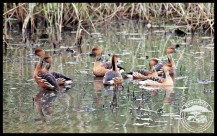Dendrocygna bicolor
Probably as is to be expected, the long-legged Fulvous Whistling Duck is usually found at or near bodies of fresh water, usually with well vegetated verges where it follows a mainly herbivorous diet that includes algae, grasses, water lilies, seeds and flowers and only occasionally taking in insects and other invertebrates. They are quite nomadic waterfowl, ranging widely in search of suitable habitat, and often found in association with the closely-related White-faced Whistling Duck. The Fulvous Whistling Duck is not often found in large flocks, usually moving around and feeding in fairly small groups. They are active both day and night.
Fulvous Whistling Ducks may breed at anytime of year, though most often shortly after good rains. Their nests are simple scrapes in the ground, usually in dense cover very near water and lined with fine plant materials. Pairs are monogamous and may mate for life. Both parents contribute to the building of the nest and the incubation of the clutch of 6-13 eggs, which hatch after about four weeks. The ducklings can fly before they’re 2 months old.
The Fulvous Whistling Duck is widely distributed over parts of Africa, Asia, North and South America, and is considered to be of least concern; the IUCN estimating the total population at as much as 1.5-million though noting that most populations are declining due to hunting and farming practices. In South Africa they are commonly found on the Highveld (mainly Gauteng) but only occasionally seen in the wild elsewhere in our country.














